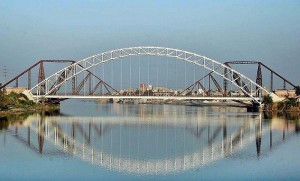Sights and Sounds of Pakistan: Sukkur part-1
Monday, April 23rd, 2012 1:03:31 by Naveed A Bari
Sights and Sounds of Pakistan: Sukkur part-1
Sakhar, or Sukkur as commonly written but pronounced as the former had been a town situated on the right bank of the Indus, and part of Sind province even before the British India. It commanded the trade of Sind, and the river was once crossed
by a cantilever bridge carrying the North-Western railway to Kotri in the early 20th century.
In 1842 it came under British rule. The District Of Sukkur was created in 1901 out of part of Shikarpur district, the remainder of which was formed into the district of Larkana. It is chiefly alluvial plain, but there are slight hills at Sukkur and Rohri.
In the higher-lying parts are salt lands, or even desert in the area known as the Rajistan. The climate is hot, dry and enervating. The population in 1901 was 523,345, showing an increase of 10% in the decade.
A considerable part of the district is irrigated, the principal crops being wheat, millets, rice, pulses and oil seeds. Earthen, leathern and metal ware, cotton cloth and tussore silk are manufactured, also pipe-bowls, snuff-boxes and scissors. Lines of
the North-Western railway serve the district, and there is a branch from Sukkur towards Quetta.
Sukkur was and still continues to be a junction point for railway system for Quetta via Sibi and Jacobabad, while another highway and railway line go via Rahimyar Khan and Sadiqabad straight to Multan. Sukkur is a sprawling town, with beautiful mosques,
gardens, shrines and madrazhis (Muslim religious schools).
A desert oasis town, similar to Jaisalmer in Rajasthan, it also boasts many havelis, however, unlike those of Jaisalmer, the Sukkur variety are decorated with geometric, floral designs and painted in a variety of bright, contrasting colors. Just across the
Indus is Rohri, also fairly prosperous and an important rail and road junction.
The two towns, 5 km apart and 544 km north of Karachi are linked by the Landsdowne and Ayub bridges, which are extremely beautiful. There is a medieval mosque with porcelain-tiled walls, and eight km away are remains of the ancient city of Aror where Alexander
the Great is said to have camped.
Sukkur has been an important strategic centre and trading route from time immemorial. Alor (present Aror, Sukkur) held the status of capital under the reign of Musikanos, when Alexander invaded India in 326 BCE.
To be continued…
Tags: India, Kashmir, Nepal, WBOShort URL: https://www.newspakistan.pk/?p=19926

















